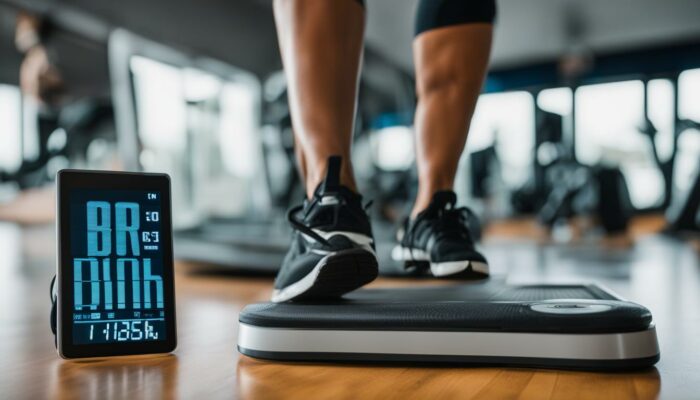Welcome to our BMR Calculator! If you’re looking to understand your body’s energy expenditure at rest, you’ve come to the right place. Our calculator takes into account factors such as age, gender, height, and weight to provide an estimate of the calories burned in a post-absorptive state. Whether you’re aiming for weight loss, or weight gain, or want to track your calorie intake, understanding your Basal Metabolic Rate (BMR) is a great starting point.
Key Takeaways:
- Calculate your BMR with our online calculator for accurate estimations.
- BMR is the amount of energy expended at rest and serves as a foundation for setting weight management goals.
- Factors such as age, gender, height, and weight influence BMR calculations.
- Use the BMR calculation to determine calorie needs for weight loss, weight gain, or calorie tracking.
- Remember to consult with a healthcare professional or certified specialist for personalized advice.
What is Basal Metabolic Rate (BMR)?
The Basal Metabolic Rate (BMR) is a fundamental concept in understanding the body’s energy expenditure. It refers to the amount of energy required by the body to maintain vital functions while at complete rest in a neutral environment. This means that the digestive system is inactive, and the body is not engaged in any physical activity.
The BMR represents the calories burned by the body to sustain essential organs like the heart, brain, kidneys, and muscles. It accounts for the largest proportion of an individual’s total caloric needs. Calculating BMR is vital as it provides a baseline for estimating the number of calories required each day.
Several formulas can be used to calculate BMR, such as the Mifflin St Jeor, Revised Harris-Benedict, and Katch-McArdle equations. These equations consider factors such as weight, height, age, and gender to estimate the calories burned at rest. By multiplying the BMR by a factor specific to activity level, daily caloric needs can be determined for weight loss, weight gain, or calorie tracking.
Factors Affecting BMR
Various factors can influence an individual’s BMR. Muscle mass plays a significant role, as more muscle increases BMR, while a decrease in muscle mass lowers it. Age also affects BMR, with older individuals generally having a slower metabolism. Genetics, weather conditions, diet, pregnancy, and certain supplements can also impact BMR. For example, cold environments raise BMR due to increased energy expenditure in maintaining body temperature. Similarly, diet plays a role, with small and frequent meals boosting BMR, while starvation reduces it.
Modern Wisdom for BMR Calculation
Despite using precise formulas, it’s important to note that there is still a margin of error in BMR measurements. Age, body composition, and other metabolic processes contribute to the variance. Therefore, while BMR calculations provide a strong foundation for setting goals, they may not yield exact measurements. Keeping a journal of exercise and food consumption can help track progress and make necessary adjustments to achieve personal goals effectively.
How to Calculate BMR?
Calculating the Basal Metabolic Rate (BMR) is a straightforward process that can be done using various equations. These equations take into account factors such as weight, height, age, and gender to estimate the number of calories burned at rest. There are three commonly used formulas: Mifflin St Jeor, Revised Harris-Benedict, and Katch-McArdle.
The Mifflin St Jeor equation is considered the most accurate and is suitable for both men and women. It considers weight, height, age, and gender to calculate BMR. The formula for men is BMR = (10 × weight in kg) + (6.25 × height in cm) – (5 × age in years) + 5. For women, the formula is BMR = (10 × weight in kg) + (6.25 × height in cm) – (5 × age in years) – 161.
The Revised Harris-Benedict equation is another commonly used formula for calculating BMR. It is similar to the Mifflin St Jeor equation but has slightly different coefficients. The Katch-McArdle equation, on the other hand, is more accurate for individuals who know their body fat percentage. It uses body fat percentage instead of gender in the calculation.
| Equation | Gender | Formula |
|---|---|---|
| Mifflin St Jeor | Male | BMR = (10 × weight in kg) + (6.25 × height in cm) – (5 × age in years) + 5 |
| Mifflin St Jeor | Female | BMR = (10 × weight in kg) + (6.25 × height in cm) – (5 × age in years) – 161 |
| Revised Harris-Benedict | Male | BMR = (13.75 × weight in kg) + (5 × height in cm) – (6.75 × age in years) + 66 |
| Revised Harris-Benedict | Female | BMR = (9.56 × weight in kg) + (1.85 × height in cm) – (4.68 × age in years) + 655 |
| Katch-McArdle | N/A | BMR = (370 + (21.6 × lean body mass in kg) |
Factors That Affect BMR
The Basal Metabolic Rate (BMR) is influenced by several factors that can impact the amount of energy expended while at rest. Understanding these factors can help individuals make informed decisions about their calorie needs and weight management goals.
1. Muscle Mass: The amount of muscle mass in the body plays a significant role in determining BMR. Muscle tissue is more metabolically active than fat tissue, meaning that it burns more calories at rest. Individuals with higher muscle mass tend to have a higher BMR.
2. Age: BMR tends to decrease with age. As we get older, our muscle mass tends to decline, which can result in a slower metabolism and a lower BMR. Regular exercise, including resistance training, can help minimize the decline in muscle mass and support a healthy BMR.
3. Genetics: Genetic factors passed down from our ancestors can also influence BMR. Some individuals may naturally have a higher or lower BMR based on their genetic makeup. While genetics cannot be changed, awareness of this factor can help individuals understand their unique metabolic needs.
Genetics play a role in determining our BMR, but it’s important to remember that they are not the sole determining factor. Lifestyle choices, such as diet and exercise, can also have a significant impact on our metabolism and overall health. – Dr. Sarah Thompson, Nutrition Specialist
4. Weather Conditions: Environmental factors, such as weather conditions, can affect BMR. Cold environments, for example, can cause the body to work harder to maintain its core temperature, leading to an increase in BMR. Similarly, hot and humid conditions can also increase BMR as the body works to cool itself down.
| Factors Affecting BMR | Effect |
|---|---|
| Muscle Mass | Higher muscle mass can increase BMR |
| Age | BMR tends to decrease with age |
| Genetics | Genetic factors can influence BMR |
| Weather Conditions | Cold environments can increase BMR |
5. Diet: The type and quantity of food we consume can also affect BMR. Eating small, frequent meals throughout the day can increase BMR as the body works to digest and metabolize food. On the other hand, restrictive diets or prolonged periods of fasting can decrease BMR as the body enters a state of energy conservation.
6. Pregnancy: BMR increases during pregnancy to support the growing fetus and the changes that occur in a woman’s body. Hormonal changes also play a role in increasing BMR during pregnancy. Pregnant women need to consult with their healthcare provider to ensure they meet their increased calorie needs while maintaining a healthy weight.
7. Supplements and Medications: Certain supplements and medications can impact BMR. For example, stimulant medications and some weight loss supplements can increase BMR temporarily, while certain medications used to treat medical conditions may decrease BMR. It’s essential to consult with a healthcare professional before taking any supplements or medications that claim to affect metabolism.
By considering these factors that affect BMR, individuals can gain a better understanding of their unique metabolic needs. This knowledge can help inform decisions about diet, exercise, and overall lifestyle choices that support a healthy BMR and contribute to overall well-being.

BMR Tests and Measurement
Accurately measuring Basal Metabolic Rate (BMR) is crucial for understanding individual calorie needs and achieving weight management goals. Various methods can be employed to test and measure BMR, each with its advantages and limitations.
BMR Tests:
- Online Calculators: BMR calculators available online use formulas derived from statistical data to estimate BMR. While convenient, these tests may not provide the most accurate results due to individual variations.
- Calorimetry Devices: Calorimetry devices, found in healthcare settings and fitness centers, offer a more precise measurement of BMR. These devices analyze heat production to determine energy expenditure at rest.
It’s important to note that BMR calculations and measurements provide estimates and may not reflect an individual’s exact metabolic rate. However, they serve as a useful starting point for setting calorie targets and monitoring progress.
Understanding BMR is essential to develop effective weight management strategies. With the right tools and guidance, individuals can make informed decisions about their calorie intake and activity levels to achieve their desired health outcomes.

| Methods | Advantages | Limitations |
|---|---|---|
| Online Calculators | – Convenient and accessible – Quick estimation of BMR |
– May not be the most accurate – Results can vary depending on the formulas used |
| Calorimetry Devices | – Provides precise measurement – Analyzes heat production |
– Usually available in healthcare or fitness settings – Requires specialized equipment |
While online calculators offer convenience, calorimetry devices provide more accurate measurements. Consulting with healthcare professionals or certified specialists can help individuals choose the most appropriate method for determining their BMR.
Resting Metabolic Rate (RMR) vs. BMR
Resting Metabolic Rate (RMR) is often used interchangeably with Basal Metabolic Rate (BMR), but there is a slight difference between the two. RMR represents the rate at which the body burns energy in a relaxed but not fully inactive state. BMR, on the other hand, is measured under strict conditions where the person should be completely rested and their sympathetic nervous system inactive. While BMR is considered the largest component of total caloric needs, RMR can be influenced by contextual limitations and conditions during measurement.
To understand the difference between RMR and BMR, imagine yourself in a state of complete rest. BMR represents the energy needed to sustain your vital organs and functions while lying in bed, motionless. RMR, however, takes into account the fact that even when relaxed, you may still engage in minimal activities, such as fidgeting or adjusting your posture, which require a small amount of energy. This is why RMR is slightly higher than BMR in most cases.
It is also worth noting that RMR is often used in practical settings and research studies due to its measurement flexibility. Calculating BMR accurately requires more controlled conditions, making it less applicable outside of laboratory settings. RMR, on the other hand, can be estimated using equations such as the Harris-Benedict formula or measured through indirect calorimetry, which provides a more practical approach to determining daily caloric needs.
| BMR | RMR |
|---|---|
| Measured under strict conditions | Measured in a relaxed but not fully inactive state |
| Represents energy needed at complete rest | Accounts for minimal activities even when at rest |
| Less applicable outside of lab settings | More practical for estimating daily caloric needs |
Understanding the difference between RMR and BMR can help individuals make informed decisions when it comes to managing their weight and caloric intake. By considering both RMR and BMR, along with other factors such as physical activity and diet, individuals can create a more comprehensive approach to achieving their health and wellness goals.
Modern Wisdom for BMR Calculation
When it comes to calculating Basal Metabolic Rate (BMR), it’s important to understand that even with precise formulas and equations, there is still a 26% unknown variance in BMR measurement between individuals. This means that BMR calculations are estimates rather than exact measurements. Several factors contribute to this variance, including age, body composition, and other metabolic processes.
To achieve the most accurate estimation of BMR, it’s essential to consider these factors and use the appropriate formula for calculation. Keeping a journal of exercise and food consumption can also help track progress and determine the best approach to reach personal goals.
“BMR calculations provide a foundation for setting goals but may not provide exact measurements.”
While BMR calculations may not provide precise measurements, they still serve as a valuable tool for setting goals and making informed decisions. By understanding the estimated calorie expenditure at rest, individuals can adjust their calorie intake accordingly to achieve weight loss or gain. It’s important to note that actual weight loss results may vary due to factors such as exercise, diet, and individual differences.
| BMR Calculation Accuracy | BMR Variance | BMR Precision |
|---|---|---|
| Estimates | 26% variance | Not exact measurements |
While BMR calculations provide valuable insights, it’s crucial to consult with a healthcare professional or certified specialist for personalized advice. They can provide guidance based on individual circumstances and help ensure the most effective approach to reaching weight management goals.
Understanding BMR and Weight Loss
When it comes to weight loss goals, understanding your Basal Metabolic Rate (BMR) is essential. BMR serves as the foundation for determining the number of calories your body needs to maintain its weight. By knowing your BMR, you can create an appropriate calorie deficit to achieve weight loss successfully.
However, it’s important to note that BMR calculations are estimates and not exact measurements. Other factors such as exercise, diet, and individual differences can influence the actual results of weight loss. Therefore, it’s crucial to keep a journal and make adjustments over time based on your progress.
“BMR plays a crucial role in weight loss goals by providing a foundation for determining calorie needs.”
Keeping track of your exercise routine and food consumption will help you monitor your progress more effectively, allowing you to tailor your approach to meet your personal weight loss goals. Remember, successful weight loss is a journey that requires consistency and patience.
The Impact of BMR on Weight Loss
Your BMR is the number of calories your body needs to perform its basic functions while at rest. It represents the energy required to maintain vital organs such as the heart, brain, and kidneys. By creating a calorie deficit below your BMR, you force your body to use stored fat as fuel, resulting in weight loss.
| Calorie Intake | Weight Loss Effect |
|---|---|
| Calorie Deficit (BMR – 500 calories) | Steady weight loss of approximately 1 pound per week |
| Calorie Deficit (BMR – 1000 calories) | Rapid weight loss of approximately 2 pounds per week |
It’s important to create a calorie deficit that is sustainable and healthy for your body. Drastic calorie restrictions can lead to muscle loss, nutrient deficiencies, and a slower metabolism in the long run. Consult with a healthcare professional or a certified specialist to determine the appropriate calorie deficit for your weight loss goals.
Maximizing Weight Loss with BMR
In addition to creating a calorie deficit based on your BMR, there are other strategies you can incorporate to maximize weight loss. These include:
- Incorporating regular physical activity to burn additional calories and increase your BMR
- Eating a balanced diet that includes lean proteins, whole grains, fruits, and vegetables
- Avoiding crash diets and focusing on long-term, sustainable lifestyle changes
- Staying consistent with your weight loss efforts and adjusting your calorie intake as needed
By combining these strategies with a thorough understanding of your BMR, you can optimize your weight loss journey and achieve your goals healthily and sustainably.
BMR Calculation and Daily Calorie Needs
When it comes to managing weight and tracking calorie intake, understanding your Basal Metabolic Rate (BMR) is essential. BMR calculations provide an estimate of the calories you burn at rest, which serves as a foundation for determining your daily calorie needs.
To calculate your BMR, you can use one of the various formulas available, such as the Mifflin St Jeor, Revised Harris-Benedict, or Katch-McArdle equations. Once you have your BMR, you can multiply it by a factor that corresponds to your activity level. This will help you determine the total number of calories you need per day to maintain your weight, lose weight, or gain weight.
For individuals who lead an active lifestyle, accurately tracking their daily calorie needs is crucial. By knowing your BMR and understanding how it relates to your calorie intake, you can ensure that you are fueling your body properly and aligning your caloric intake with your weight management goals.
This table presents a comprehensive overview of BMR calculations and daily calorie needs based on activity levels. It highlights the varying caloric requirements for individuals with different activity levels, from sedentary to very active. By selecting the appropriate activity level and corresponding caloric intake, you can better track your calorie consumption and make informed decisions about your diet and exercise routine.
BMR and Gender Differences
Gender differences play a significant role in Basal Metabolic Rate (BMR) calculations. BMR formulas are specifically designed for men and women due to variations in body composition and hormonal factors. Men generally have a higher BMR compared to women because they typically have more muscle mass, which requires more energy to maintain. On the other hand, women tend to have a lower BMR due to lower muscle mass and hormonal differences.
The difference in BMR between men and women highlights the importance of using the appropriate equation based on gender when calculating BMR. By accounting for these gender differences, individuals can obtain more accurate estimations of their BMR and better understand their daily caloric needs.
Table: Comparison of BMR Formulas for Men and Women
| BMR Formula for Men | BMR Formula for Women | |
|---|---|---|
| Formula | Mifflin St Jeor Equation for Men | Mifflin St Jeor Equation for Women |
| Factors Considered | Weight, height, age | Weight, height, age |
| Muscle Mass | Higher muscle mass leads to higher BMR | Lower muscle mass leads to lower BMR |
| Hormonal Factors | N/A | Hormonal differences can affect BMR |
It’s important to note that while gender differences impact BMR calculations, individual variations can occur within each gender. Factors such as body composition, genetics, and overall health can further influence an individual’s BMR. Therefore, BMR calculations should be used as a starting point and adjusted based on personal observations and progress.
BMR and Aging
As individuals age, their metabolism naturally slows down, leading to a decrease in Basal Metabolic Rate (BMR). This decline in BMR is primarily attributed to a decrease in muscle mass and hormonal changes that occur with age. Muscle is metabolically active tissue, meaning it requires more energy to maintain compared to fat. Therefore, as muscle mass decreases, the body burns fewer calories at rest, resulting in a lower BMR.
Elderly individuals need to be aware of these changes in BMR and adjust their calorie intake accordingly. Consuming excess calories without considering the decrease in metabolism can lead to weight gain and potential health issues. On the other hand, consuming too few calories can result in inadequate nutrient intake and muscle loss. It is recommended that elderly individuals work with a healthcare professional or registered dietitian to determine their appropriate calorie needs based on their BMR, activity level, and overall health goals.
Effects of Aging on BMR
When it comes to BMR and aging, several factors contribute to the decline in metabolism. These include:
- Loss of muscle mass: Sarcopenia, the age-related loss of muscle mass, leads to a decrease in BMR.
- Hormonal changes: Hormonal fluctuations, such as a decrease in growth hormone and testosterone, can further contribute to a decline in metabolism.
- Physical activity level: Older individuals may become less active, resulting in reduced energy expenditure and a decrease in BMR.
While aging is associated with a decrease in BMR, incorporating regular physical activity and strength training exercises can help mitigate some of these effects. Exercise helps preserve and build muscle mass, which can increase BMR and overall metabolic rate. Additionally, a well-balanced diet that provides adequate protein, vitamins, and minerals is crucial for supporting muscle health and maintaining a healthy metabolism as we age.
Conclusion
In conclusion, the BMR Calculator is a valuable tool for individuals seeking to manage their weight and track their calorie intake. By estimating the calories burned at rest, the BMR Calculator provides a foundation for setting weight loss or gain goals. However, it is important to note that BMR calculations are not exact measurements and can vary among individuals.
Factors such as age, gender, body composition, and activity level can influence BMR, leading to variations in calorie needs. It is crucial to consider these factors and make adjustments based on personal progress and goals. Keeping a journal of exercise and food consumption can help track progress and determine the most effective approach for weight management.
While the BMR Calculator is a useful tool, it is always recommended to consult with a healthcare professional or certified specialist for personalized advice. They can provide tailored guidance and support based on individual needs and circumstances. By combining the information from the BMR Calculator with professional guidance, individuals can achieve successful weight management and overall well-being.
References
- Basal metabolic rate and risk of multiple sclerosis: a Mendelian randomization study:
- Liu C, Lu Y, Chen J, Qiu W, Zhan Y, Liu Z. Basal metabolic rate and risk of multiple sclerosis: a Mendelian randomization study. Metab Brain Dis. 2022 Aug;37(6):1855-1861. doi: 10.1007/s11011-022-00973-y. Epub 2022 May 11. PMID: 35543713. Link
- Basal metabolic rate: history, composition, regulation, and usefulness:
- Hulbert AJ, Else PL. Basal metabolic rate: history, composition, regulation, and usefulness. Physiol Biochem Zool. 2004 Nov-Dec;77(6):869-76. doi: 10.1086/422768. PMID: 15674762. Link
- Basal metabolic rate in pregnant adolescents:
- Sally EOF, Anjos LA, Ramos EG, Fonseca VM, Silva BAM, Wahrlich V. Basal metabolic rate in pregnant adolescents. Clin Nutr ESPEN. 2018 Oct;27:134-136. doi: 10.1016/j.clnesp.2018.05.014. Epub 2018 Jun 19. PMID: 30144886. Link
- Regulation of basal metabolic rate in uncomplicated pregnancy and in gestational diabetes mellitus:
- Taousani E, Savvaki D, Tsirou E, Poulakos P, Mintziori G, Zafrakas M, Vavilis D, Goulis DG. Regulation of basal metabolic rate in uncomplicated pregnancy and in gestational diabetes mellitus. Hormones (Athens). 2017 Jul;16(3):235-250. doi: 10.14310/horm.2002.1743. PMID: 29278510. Link
- Effect of basal metabolic rate on osteoporosis: A Mendelian randomization study:
- Zhou J, Ye Z, Wei P, Yi F, Ouyang M, Xiong S, Liu Y, Li J, Liu M, Xi H, Peng Q, Xiong L. Effect of basal metabolic rate on osteoporosis: A Mendelian randomization study. Front Public Health. 2023 Feb 1;11:1096519. doi: 10.3389/fpubh.2023.1096519. eCollection 2023. PMID: 36817914. Link
FAQ
What is a BMR Calculator?
A BMR Calculator is a tool that estimates the amount of energy expended while at rest, also known as the Basal Metabolic Rate (BMR).
How is Basal Metabolic Rate (BMR) calculated?
BMR can be calculated using various formulas such as the Mifflin St Jeor, Revised Harris-Benedict, or Katch-McArdle equations. These formulas take into account factors like weight, height, age, and gender.
What factors can affect BMR?
Several factors can influence BMR, including muscle mass, age, genetics, weather conditions, diet, pregnancy, and certain supplements or drugs.
How is BMR measured?
BMR can be measured through online calculators or using calorimetry devices found in health and fitness centers. Online tests provide estimates, while calorimetry devices measure BMR more precisely by analyzing heat production.
What is the difference between BMR and Resting Metabolic Rate (RMR)?
BMR is measured under strict conditions with the person completely rested and their sympathetic nervous system inactive. RMR represents the rate at which the body burns energy in a relaxed but not fully inactive state.
How accurate are BMR calculations?
BMR calculations are estimates and can have a 26% unknown variance between individuals. Age, body composition, and metabolic processes contribute to this variance.
How does BMR relate to weight loss?
BMR plays a crucial role in weight loss goals by providing a foundation for determining calorie needs. By knowing their BMR, individuals can establish an appropriate calorie deficit to achieve weight loss.
How can BMR help with calorie tracking?
BMR calculations can be used to estimate daily calorie needs based on activity level. By multiplying the BMR by a factor specific to activity level, individuals can determine the total number of calories needed for weight management.
Are there gender differences in BMR?
Yes, there are separate formulas for men and women due to variations in body composition and hormonal factors. Men generally have a higher BMR due to more muscle mass, while women tend to have a lower BMR.
How does BMR change with age?
BMR tends to decrease with age, as older individuals typically have less muscle mass and may experience hormonal changes. Regular exercise, including resistance training, can help maintain muscle mass and support a healthy BMR.





![NootropX Review [year] - Side Effects & Ingredients: Boost Your Cognitive Performance NootropX Review ([year]) - Side Effects & Ingredients](https://www.miriamwellness.com/wp-content/uploads/2023/11/NootropX-Review-2023-Side-Effects-Ingredients-150x150.jpg)